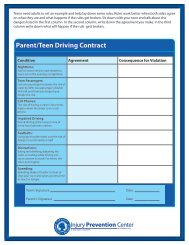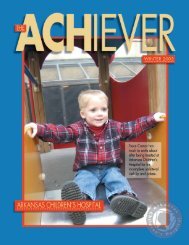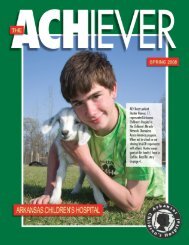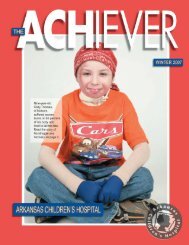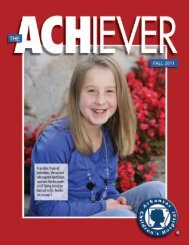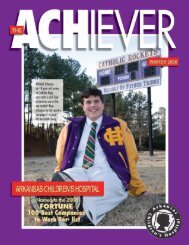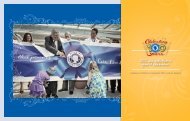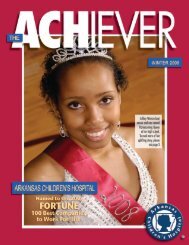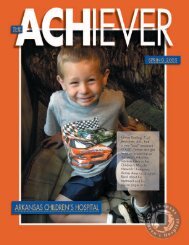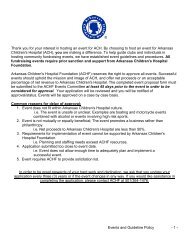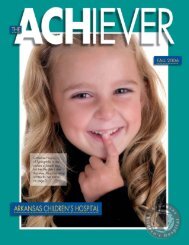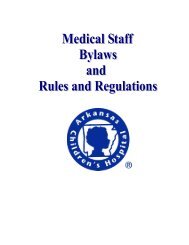Fall/Winter 2008 - Arkansas Children's Hospital
Fall/Winter 2008 - Arkansas Children's Hospital
Fall/Winter 2008 - Arkansas Children's Hospital
- No tags were found...
Create successful ePaper yourself
Turn your PDF publications into a flip-book with our unique Google optimized e-Paper software.
FREE!parentingarchildrens.orgA PUBLICATION OF ARKANSAS CHILDREN’S HOSPITAL<strong>Fall</strong>/<strong>Winter</strong> <strong>2008</strong>/Vol.18/No. 2IN ARKANSASHelpingChildrenManageSTRESSMoral Development:Helping Children Become Good PeopleYOUR DEVELOPING CHILD• Childhood Immunization Myths• Building Friendships That Last a Lifetime• Your Teen and the Open RoadSPECIAL INSERTTips for Parents toMake the Most of Parent-Teacher Conferences
CONTENTSFeatures48HELPING CHILDREN MANAGE STRESSNo child is too young to experience stress, and they haven’t developed the reasoning skills to helpthem cope with what’s bothering them. Dr. Janice Church can help parents be aware of subtle occurrencesthat can send children’s minds wandering – and worrying. Learn ways to identify, and problem-solvethese situations with your youngster.MORAL DEVELOPMENT: HELPING CHILDREN BECOME GOOD PEOPLEHow do you raise a child who can help make this world a better place? Dr. Wallace Goddard offerssome suggestions that are simple, yet realistic. Even parents can benefit from these ideas that canoffer profound results.Departments7IN REVIEWGreat books for children of all ages, and a little help for parents inthe area of raising a kid with nice manners! The Central <strong>Arkansas</strong>Library System has scouted out books for everyone in the family.ON THE COVERMicah Bernard and her fatherAndré Bernard(more photos on page 8)of Little Rock, <strong>Arkansas</strong>Photo by Kelley CooperVisit the<strong>Arkansas</strong> Children’s <strong>Hospital</strong>Web site at: archildrens.org“Parenting in <strong>Arkansas</strong>”is made possible through thesupport of the Circle of Friendsfor <strong>Arkansas</strong> Children’s <strong>Hospital</strong>.2Circle ofFriends111214KIDS IN THE KITCHENThree nutrition experts, Dr. Margaret Bogle, Sandra Nissenberg,and Audrey Wright have cut to the chase when it comes to preparingfast meals your children will enjoy cooking and eating! With ahandful of ingredients, and preparation time in a flash, dinner willbe on the table in no time! And don’t miss the dog bones for kids– for dessert!KIDSTUFFLearn more about <strong>Arkansas</strong>, the Natural State, by visiting any of thefour Nature Centers, operated by the <strong>Arkansas</strong> Game and Fish Commission.Located in different areas of <strong>Arkansas</strong>, children take homea unique experience after each visit.BORED NO MOREThere can be a world of discovery as close as your kitchen, and unlimitedscience experiments to be explored! These ideas from the<strong>Arkansas</strong> Discovery Network are fun – and you’ll even learn a fewthings about the world we live in!
Departments16WHAT’S NEW AT ACH?A new name for the street that runs through the heart of our campusshows who’s No. 1 with us! Plus, learn how we can detectproblems with babies’ hearts, even before they’re born. And – ourfavorite Wayfinding dog, Scout, is showing up all around ACH.Learn how he can help you when you visit ACH.18YOUR DEVELOPING CHILDPrenatal – Pregnancy Relaxation & Techniques0-2 – Childhood Immunizations Myths3-5 – Through My Eyes6-12 – Building Friendship Skills that Last a LifetimeTeens – Your Teen and the Open Road23FOR YOUR EDUCATIONThe Center for Effective Parenting/<strong>Arkansas</strong> State PIRC offers free parenting classes coveringa variety of topics meant to strengthen the family, guide children (and parents) through thechallenges of childhood and improve children’s academic achievement, while also offeringgeneral parental and safety advice.Editorial Staff/Board of Advisors1 Children’s Way • Little Rock, AR 72202-3591 • (501)364-4300 or (TDD)364-1184 • FAX (501)364-3988<strong>Arkansas</strong> Children’s <strong>Hospital</strong> publishes Parenting in <strong>Arkansas</strong> as a community service to provide parents with information to become better informed and more effectiveparents. The magazine addresses a broad range of issues relevant to parenting children from the prenatal period through adolescence. The Board of Editorial Advisors,composed of professionals and parents, provides guidance in determining publication content. To order your free subscription, contact the numbers above.Disclaimer: The opinions expressed in this magazine’s articles are those of the authors and not necessarily those of <strong>Arkansas</strong> Children’s <strong>Hospital</strong>.EDITOR: Ginger Daril, Public Relations, <strong>Arkansas</strong> Children’s <strong>Hospital</strong>MANAGING EDITOR: Nicholas Long, PhD, Department of Pediatrics, UAMS College of Medicine, <strong>Arkansas</strong> Children’s <strong>Hospital</strong>DESIGN, LAYOUT & ILLUSTRATIONS: Michael Spigner, Manager of Publications, Public Relations, <strong>Arkansas</strong> Children’s <strong>Hospital</strong>BOARD OF ADVISORSACH REPRESENTATIVESIda Collier<strong>Arkansas</strong> Service CommissionDee Cox<strong>Arkansas</strong> Department of EducationMardi CrandallInfant Development Center, U of AMarti GengePages of Parenting BookstoreBarbara Gilkey<strong>Arkansas</strong> HIPPY ProgramWally Goddard, PhDUniversity of <strong>Arkansas</strong>Cooperative Extension ServiceDiane LaFollette<strong>Arkansas</strong> Museum of DiscoveryBonnie Limbird, LCSWKids First, UAMSSharon LongCenters for Youth and FamiliesGlenn Lowitz, PhDLowitz and Clark Medical OfficesSue Martin, PhDSchool of HumanEnvironmental Services, U of ASherri McLemoreChild Abuse & NeglectPrevention BoardNathan Pittman<strong>Arkansas</strong> Adovcates forChildren and FamiliesLinda RobinsonDivision of Children andFamily Services, DHSAmy Rossi<strong>Arkansas</strong> Center forHealth ImprovementChris SmithDepartment of Pediatrics,UAMS/ACHCarol Snelson, PhDCenter for Developmental Skills,UALRTracy L. SteeleSTAND FoundationDan McFadden, APRDirector of CommunicationsJeanette PerdueVice President, OperationsCarole ZylmanSenior Vice Presidentof Medical Services3
What Causes Stress in Children?Stress is a natural part of growing up. Childhood stress maybe caused by everyday experiences such as conflicts with friends,school challenges, family problems, or even peer pressures relatedto popularity, appearance, and athletic skills. Some children maybe exposed to financial difficulties, moves, or parents changingjobs. Others may experience the loss of family members, friends,or pets. Although less common, some children must deal withother life-changing events such as military deployment, weatherdisasters, or fires. Even positive events, such as starting the schoolyear or bringing a new baby into the family may be stressful. Acertain amount of stress in our lives is considered healthy.Very young children can experience stress too, and everychild reacts in their own way. Children are more likely to haveproblems dealing with stress because they have not yet learnedhealthy ways to cope. Parents have a huge responsibility in teachingchildren these strategies. The way children learn to handlestress when they are young will be the way they will handle stressthroughout their lives.How Do We Help ChildrenCope with Stress?Recognize Signs of StressJust being able to identify stress reactions and symptomswill go a long way in helping children take steps to manage theirstress. Parents can help their children recognize their body’s stresssignals, such as tense muscles, sweaty palms, headache, upsetstomach, restlessness, problems sleeping, and irritability or moodchanges.Normalize FeelingsLet children know that what they are feeling is normal, andthat others may feel the same. Parents can share a stressful timewhen they had similar feelings to help their children understandthat such feelings are normal.Set a Good ExampleChildren pay close attention to what parents say and do.They learn by watching others and learn to use the coping skillsthat others around them use. Parents must model positive ways tocope. For example, taking good care of yourself physically canhelp your body be better prepared to handle stress. Eating healthfulfoods, watching your weight, getting enough sleep and exercise,and having a balanced schedule is important. This includesmaking time for relaxation and fun, and surrounding yourself witha support system of family and friends. Remaining positive, tacklingproblems head on, and looking at all possible solutions whenmaking decisions are all good strategies to model for your child.Have a Consistent RoutineParents are responsible for providing structure, rules, and routinesfor their children. Such routines help children know what toexpect and help reduce anxiety when uncontrollable events happen.Regular routines should be maintained while dealing with stressfulevents. For example, if a child’s bedtime was 8 p.m. before a tornadodamaged the family home, that same bedtime routine shouldbe followed while the family is living in a shelter during the repairof their home.Encourage Open CommunicationParents are usually their child’s best resource for getting helpwith problems. It is important that parents encourage open communicationwith their children. When children know that parentsare available and willing to listen, they’ll be more likely to turnto them for support and reassurance when they are stressed. Parentscan help children express their thoughts and feelings aboutstressors by asking open-ended questions (“What was that like foryou?”). A warm hug or pat on the back will go a long way in lettingchildren know that parents understand and are there for them.Parental support is often critical in determining how well childrenwill learn to cope with stressful situations.Prepare Children for Handling StressEarly intervention is important so stress reactions don’t get outof hand. Parents should prepare children for potentially stressfulcircumstances and encourage them to begin using stress managementskills at the first signs they are feeling stressed. Stress is inevitable,and parents should not shield children from experiencingit. Rather, they should help children rehearse or practice possiblesolutions to problems or potential difficulties. For example, parentsmight role-play with their children what they would say anddo the next time they encounter the bully at school.Practice Decision-Making SkillsChildren are better prepared to handle stress when they feelgood about themselves and have confidence they can handleproblems. It is important for parents to give children increasingamounts of responsibility and supervised practice in decision-makingover the course of their growing-up years. This prepares childrento think quickly and independently when faced with difficultcircumstances. Parents should take every opportunity to encourageand praise their child for successes and good decision-making.STRESSContinued on page 65
IN REVIEWReading Can Be Fun for The Entire FamilyAt Your Local LibraryBy Carrie Snodgrass, Central <strong>Arkansas</strong> Library SystemEvery FridayBy Dan YaccarinoA picture book for young readers.Every Friday a young boyand his father set off from theirapartment, leaving mom andthe baby behind. This is theirspecial father-son time whichinvolves a walk to the diner forbreakfast. They greet peoplethey see along the way, windowshop the stores they pass,count the dogs they see, andmail some letters all while enjoyinga leisurely stroll throughthe neighborhood. With veryfew words on each page, thissimple storybook brings to lifethe youngster’s excitement ofspending time alone with dad. Yaccarino’s note at the beginningof the book tells readers that he himself started this weekly breakfasttradition with his son and hopes readers will do the same.This book is perfect for family sharing and adds opportunities forfathers to share some special time with their children.Behind YouBy Jacqueline WoodsonA novel for young adults.Ellie and Jeremiah (Miah)are in love. They are both inhigh school, 15-years-old, buteveryone around them can seethese two have found the realthing! But when tragedy strikesand Miah is killed by mistake,everyone who knew him has tobegin the difficult journey backto life without Miah.This is a sensitive and tenderstory about loss, grief andhope. In this story, which is acontinuation of “If You ComeSoftly,” the author exploreshow people deal with the lossof a loved one, a friend, an acquaintanceor even just a fellow student. Woodson captures thefirst stages of denial, anger and numbness. The author has sofinely crafted the story that the reader feels great empathy for thecharacters.Horse Hooves and ChickenFeet: Mexican FolktalesBy Neil PhilipA nonfiction book for grade school children.Manners in the LibraryBy Carrie FinnA nonfiction book for parents.This short and simple nonfiction book can help parents preparetheir children for a visit to the library. Library situations areThis colorful folktale collectionhas a true Mexican flavor.discussed and children are shown using the appropriate goodmanners in each situation. “Mark’s books are due on Friday. HeAll of the stories were collectedfrom storytellers through-returns his books on time. He is using good manners.” With theseclear examples the author highlights the behavior that parents andout Mexico and the Southwestlibrarians expect from library visitors. This title is a part of theUnited States. Readers willWay to Be! series by Picture Window Books. Each book coverslearn how Mexican folktalesappropriate manners for different situations, such as Manners atblend religion, humor and moralsto bring about stories withSchool, Manners at the Table, or Manners on the Telephone. Eachtitle is written along the same format, adding situations unique toroots deep in the culture. Theeach environment. This series is an excellent way for parents tocollection of stories in thisprepare their children when visiting a new place or reinforcingwork includes a story similarto Cinderella in “The Twogood manners in everyday life.Marias” and a trickster tale in“Pedro the Trickster.” Thesefolktales are perfect for readingaloud and offer many storytellingopportunities. 7
KIDS IN THE KITCHENQuick Meals for Healthy Kids and Busy ParentsQuick Meals For Healthy Kids and Busy Parents by SandraK. Nissenberg, M.S.R.D., Margaret Bogle, Ph.D., R.D., and AudreyC. Wright, M.S., R.D., is authored by native Arkansans whohave definitely done their research! Enjoy this sampling fromtheir book and enjoy the time you save!Taco BaLLsIf your children like tacos, here’s a different take on the recipethey will love to make! For a less spicy taste, cut back onthe amount of taco seasoning you include. To balance your meal,serve with salsa, Spanish rice or fruit cocktail.Ingredients1 pound lean ground beef (uncooked)1 1 /4 oz. package taco seasoning mix1 /2 to 3 /4 cup water1 cup cheddar cheese, shredded3 cups dry biscuit mix (low-fat mix is acceptable and has fewercalories)Preheat oven to 350 degrees. Combine all ingredients in largebowl. (Remember, the meat is uncooked.) Shape the mixture intosmall balls. Bake on ungreased cooking sheet for 15 to 20 minutesor until browned. Makes 40 taco balls.62 calories per serving (serving size, one taco ball). 4 gm protein,4 gm carbohydrates, 4 gm fatDump SoupChildren can easily help make this recipe! All they have to dois – dump!Ingredients1 pound lean ground beef2 10 3 /4 oz. cans minestrone soup16 oz. can ranch style beans2 16 oz. cans stewed tomatoes15 oz. can whole kernel corn1 cup frozen hash brown potatoesBrown beef and drain. Combine meat with remaining ingredientsin medium-sized soup pot and bring to a boil. Reduce heatand simmer about 15 minutes. If soup appears too thick, add asmall amount of warm water. Makes 16 (3/4 cup) servings.172 calories per serving, 11 gm protein, 23 gm carbohydrates, 3gm fat, 694 gm sodium.Dog Bones (for kids)Kids can turn this snack-making activity into an art experience,and it’s a great project for after school or on a rainy daywhen everyone is entertaining themselves indoors!Ingredients1 /2 cup smooth peanut butter1 /2 cup dry milk powder1 Tbsp. honey2 large graham crackers, crushedIn a small bowl, combine peanut butter and dry milk. Addhoney and mix well. (The mixture will be stiff.) Divide into sixballs. Mold each piece into the shape of a dog bone, or any creativeshape that interests your child.Crush graham crackers in a resealable bag using a rolling pin.Sprinkle graham cracker crumbs on both sides of the dog bones.Lap them up! Makes six servings. 182 calories per bone, 9 gm protein, 14 gm carbohydrates, 11grams fat, 134 mg calcium.Copyright 1995, reprinted with permission of John Wiley & Sons Inc.11
KIDSTUFFGoodBy Jeff Williams,<strong>Arkansas</strong> Game &Fish Commission“Natured”“Education and enforcement” was the refrain from voters when Amendment 75 became lawin 1996. The public asked the <strong>Arkansas</strong> Game and Fish Commission to bolster those divisions withmoney from the Conservation Sales Tax – and it has.Three nature centers are up and running, and the fourth – the Witt Stephens Jr. Central <strong>Arkansas</strong>Nature Center – opened Dec. 17, <strong>2008</strong>, in Little Rock.Pine BluffWetlands take center stage at the Gov. Mike Huckabee Delta Rivers NatureCenter in Pine Bluff, the first AGFC nature center, which opened in 2001.The rustic look recalls a Delta hunting lodge. Features include a 20,000-gallonaquarium and a student lab. Exhibits focus on waterfowl, duck hunting andwhy the Delta is so attractive to migrating waterfowl each winter. There’s also anextensive trail system on 130 acres.The center is at 1400 Black Dog Road in Pine Bluff’s Regional Park, just offU.S. Highway 65. It’s open 8:30 a.m.-4:30 p.m. Tuesday-Saturday and 1 p.m.-5 p.m. Sunday. Call (870) 534-0011 or visit www.deltarivers.com.12JonesboroThe open-air feeling of the Forrest L. Wood Crowley’s Ridge Nature Center,which opened in Jonesboro in 2004, invites visitors to explore inside and out.There’s no rush to see it all. The building is on 160 acres laced with trails.A two-story diorama gives the experience of a typical spring day on Crowley’sRidge. A thunderstorm crosses the ridge, and rains flow through runoffs, erodingpart of the landscape. Visitors may learn about big game and nongame animals, goinside a duck blind on a winter morning, see live aquatic critters, go to the third-floorCrow’s Nest to look across the landscape into the Delta and view a film about theformation of Crowley’s Ridge. You can also vist a butterfly garden (photo at left).Crowley’s Ridge Nature Center is at 600 E. Lawson Road in southern Jonesboro.Hours are 8:30 a.m.-4:30 p.m. Tuesday-Friday, 9 a.m.-6 p.m. Saturday and 1p.m.-5 p.m. Sunday. Call (870) 933-6787 or visit www.crowleysridge.org.
Fort SmithThe Janet Huckabee <strong>Arkansas</strong> River Valley Nature Center isnot in Fort Smith – it’s on what was part of Fort Chaffee. It openedin 2006 on the shore of 12-acre Wells Lake, and tells the story ofthe land between the Ozark Plateau and the Ouachita Mountains.“Interactive displays explain how the Ouachitas and the Ozarkswere formed,” said Kelly Mulvihill, director of the center. “Thefish in our aquarium represent the fish of the <strong>Arkansas</strong> River – gar,bass, paddlefish.”An artificial post oak stretches more than 20 feet to the ceilingin the great room. An automated white-tailed deer and coveysof bobwhite quail and dove surround the base of the tree. A cornerof the room is lined with windows that overlook bird-feeding stationsand a circulating creek.“We have a bluebird box that’s big enough for kids to climbinto,” Mulvihill said.And there’s hiking on trails around the lake, plus canoes andkayaks.The center is at 8300 Wells Lake Road southwest of Barling,off <strong>Arkansas</strong> Highway 255. Hours are 8:30 a.m.-4:30 p.m. Tuesday-Saturdayand 1 p.m.-5 p.m. Sunday. Call (479) 452-3993 orcheck www.rivervalleynaturecenter.com for more information.Little RockThe most urban of the four nature centers recently openedin Little Rock’s River Market District. This one focuses on thehistory of conservation in <strong>Arkansas</strong> and the role the AGFC hasplayed in hunting, fishing and other outdoor pursuits.“Being located in a very urban area allows us to reach awide range of user groups in the community,” said Neil Curry,director of the center. “We look forward to having an activerole in reaching school groups, families and visitors to central<strong>Arkansas</strong>.”Visitors will be drawn to aquariums that represent the diverseregions and fish species of <strong>Arkansas</strong>. Displays reveal theroles of AGFC wildlife officers and biologists, and a timelinefollows the evolution of conservation in the state.“After visiting the center, guests will have a much betteridea of what the <strong>Arkansas</strong> Game and Fish Commission does andwhat has taken place in conservation over the years in <strong>Arkansas</strong>,”Curry said.The center is at 602 President Clinton Ave. It is open 1-5 p.m.Sunday and 8:30 a.m.-4:30 p.m. Tuesday-Saturday. Visit www.centralarkansasnaturecenter.com or call (501) 907-0636 formore information.13
BORED NO MOREDiscover the PowerBy Diane La Follette, <strong>Arkansas</strong> Museum of DiscoveryTry these fun activities with your kids, and learn about the power of Mother Nature atthe same time. You and your entire family will see that science can be fun, interesting andeducational.These activities are based exhibits in “Good Vibrations,” traveling the state of <strong>Arkansas</strong>thanks to the <strong>Arkansas</strong> Discovery Network, funded by the Donald W. Reynolds Foundation. Go towww.arkansasdiscoverynetwork.org/exhibits/goodvibrations.html to see the schedule and formore information.Underwater Sand DunesAs a river flows, it creates movement in the sand or dirt on theriver floor. The shapes or dunes that are created can indicate how thewater has moved. This motion is called “fluvial,” having to do with ariver. You can make your own fluvial storm and see how sand dunescan be formed and destroyed by water.Materials:Clear glass baby food jar with lidFine sandSmall pebblesFill the baby food jar 1 /4 full with sand, then add pebbles. Fill withwater, slightly overfilling to eliminate air bubbles. Secure the lid.Gently swirl the jar until only the finest sand is still swirling. Stopand observe the sand as it settles. Slowly swirl in the opposite direction,and quickly change directions. Try swirling faster.What happens to the landscape? What happens when you stop orchange directions, or when you swirl faster? Does the sand behave differentlyaround the larger pebbles?14
of Mother NatureWith Your Own HandsResonant RingsResonance happens when a wave at a frequency is amplifiedby waves of that same frequency. You can see this insound waves and seismic waves during an earthquake.Materials:Cardboard, 1 ft. long, several inches wideConstruction paper (1” x 20”)Masking or transparent tapeCut the paper into five 1-inch wide strips with lengths of20”, 17”, 14”, 11” and 9”. Make rings and tape to the cardboard(see illustration below).Shake the cardboard back and forth. Start at low frequency (shakeslow) and gradually increase to high frequency (very fast). Notice thatdifferent rings vibrate strongly, or resonate, at different frequencies. Thebiggest ring has the largest mass and the least stiffness, so it has the lowestresonant frequency. Put another way, the largest ring takes more time thanthe smaller rings to respond to an accelerating force. Resonance (vibratingat similar frequencies) can be damaging in an earthquake. If the frequencyof seismic waves is different than the frequency of the building sway, themotion won’t amplify. If they are similar, they will accelerate, causingeven greater damage.For more details on these and other activities, go tohttp://www.arkansasdiscoverynetwork.org/exhibits/gv/mini-vibes.html.15
WHAT’S NEW AT ACHConstruction of $115 MillionSouth Wing UnderwayConstruction crews are clearing the way for the creation of anew, four-story patient tower off the southwest corner of ACH’smain hospital building.The 258,000 square-foot addition will create much-neededspace for providing the highest standard of pediatric care possible.Inside, a new Emergency Department will include telemedicinetechnology and four trauma rooms, as well as a dedicated orthopedicssuite and a decontamination unit. In addition, the South Wingwill open new space for the Neonatal ICU and CardiovascularICU to accommodate the growing demand for their services. Anentirely new Hematology/Oncology unit will open for the state’spediatric cancer and blood disorder patients, and there will be anew inpatient unit dedicated for care of infants through 3-yearolds.“This new South Wing will allow<strong>Arkansas</strong> Children’s <strong>Hospital</strong> to deliveran unprecedented level of careto the kids who need it most,” saidACH President and Chief ExecutiveOfficer Jonathan Bates, MD. “We’ll be delighted tosee the day when we open its doors and can help morepatients recover and simply get back to being kids.”The South Wing will add 54 inpatient beds to thehospital’s current total of 316.WHAT’SNEWAT ARKANSASCHILDREN’SHOSPITALGinger Daril, <strong>Arkansas</strong> Children’s <strong>Hospital</strong>Children’s WayWe’re making big changes at <strong>Arkansas</strong> Children’s <strong>Hospital</strong>– on the inside and out! This fall the name of the main thoroughfarethrough campus changed from Marshall Street – to Children’sWay. It’s a small, but visible way we can show “who comes first”at ACH!When in Doubt– Follow Scout!Scout is <strong>Arkansas</strong> Children’s<strong>Hospital</strong>’s new Wayfinding dog!When you come to ACH, you willsoon notice new signs all across campusshowing you where to park, where toenter and how to quickly get to your destination.Inside, our guide dog Scout helps youfind your way through the hospital. Maps ofeach floor can also be found at the admissionsdesk in the ACH lobby.16
Heart Check-upsFor Your Unborn BabyThe Heart Center at <strong>Arkansas</strong> Children’s <strong>Hospital</strong> has expanded,with the addition of the Fetal Heart Center. Our pediatriccardiologists conduct fetal echocardiograms, a highly specializedtype of prenatal ultrasound, on a baby’s heart. Fetal abnormalitiessuch as arrhythmias, cardiac structural concerns, hydrops,extra-cardiac anomalies or chromosomal abnormalities shouldreceive a fetal echocardiogram. Expecting mothers with diabetes,a family history of congenital heart defects, exposure to medicationsthat may affect the developing heart, or other medical conditionsshould have their unborn baby examined between 20 and 25weeks gestation to monitor for any potential concerns.Fetal echocardiograms look at the structure of the unbornbaby’s heart in much more detail than the standard “4-chamberview” seen in a routine sonogram in the obstetrician’s office.Fetal echocardiograms can check for most forms of congenitalheart disease. When a baby’s body makes the transition fromliving in its mother’s womb to the real world, there are changesthat take place and certain types of heart defects may not be ableto be identified until after the baby is born.For more information on the Fetal Heart Center or to schedulea fetal echocardiogram, call the Heart Station at <strong>Arkansas</strong>Children’s <strong>Hospital</strong> at (501) 364-1818.Benton County and ACH ResearchInstitute Selected to Participatein National Children’s StudyBenton County recently was selected as a study centerfor the largest-ever investigation of child health, The NationalChildren’s Study. The National Institutes of Health awardeda $14.4 million contract to the <strong>Arkansas</strong> Children’s <strong>Hospital</strong>Research Institute (ACHRI) to facilitate the county’s involvement.The National Children’s Study will follow a representativenational sample of 100,000 children from before birth to age21. Study volunteers will be recruited throughout the UnitedStates, from rural, urban, and suburban areas, from all incomeand educational levels, and from all racial groups. The studywill investigate factors influencing the development of suchconditions as autism, cerebral palsy, learning disabilities, birthdefects, diabetes, asthma and obesity.The study in Benton County will be led by Dr. CharlotteHobbs, MD, PhD, director of the <strong>Arkansas</strong> Center for Birth DefectsResearch and Prevention at ACHRI.“This is something that the people of Benton County cancertainly be proud of. They’ll be participating in a nationalstudy that will be a legacy for their children and children tocome,” said Hobbs.ACHRI is one of 36 new and existing study centers thatwill recruit volunteers for the study, from a total of 72 locations.Additional information about the National Children’sStudy is available at http://www.nationalchildrensstudy.gov.A Home (Makeover) for JobThe design team from ABC-TV’s Extreme Makeover: HomeEdition once again reached out to a patientfrom <strong>Arkansas</strong> Children’s <strong>Hospital</strong>. Ten-yearoldJob McCully from Bigelow is a cancersurvivor who also underwent a double lungtransplant. Unhealthy living conditions forJob forced the family out of their home, butthe Extreme Makeover crew came to theirrescue! The team built a beautiful, safe, newhome for the McCullys – and dropped by fora visit at ACH where they made a lot of specialmemories getting to know many of theyoung patients, as well as Job’s doctors andnurses. They also arranged for a mini-concertfrom Christian vocalist Mark Schultz!Congratulations, Job!17
YOUR DEVELOPING CHILDSome easy pregnancy relaxation techniques include:MassageDuring pregnancy, increased pressure on the body can causepain and discomfort. Gentle massage will relax tense or tiredmuscles; such as a hand or neck massage before bed. It is recommendedto seek a professional massage therapist for whole-bodyand back massage.pPregnancy Relaxationand TechniquesBy Cindy Hubach, MDCentral Clinic for Women, Little Rockregnancy can be an exciting time for many women, especiallyfirst-time mothers. With pregnancy, come many physicalchanges and sometimes uncertainties about what to expect withthe pregnancy and labor. All of these changes and uncertaintiescan leave pregnant women stressed and anxious during theirpregnancy. There are several relaxation techniques and exerciseswomen can do to help them through this exciting but sometimesstressful time.Exercise can be a healthful and beneficial way for pregnantwomen to relieve stress. If a woman is healthy and a pregnancyis progressing normally, there are a number of exercises womencan do. Always consult your obstetrician regarding exercise. It isrecommended for women to engage in some form of moderateexercise at lease 30 minutes every day. Avoid contact sports andactivities that could lead to accidental falls.Recommendations from the American College of Obstetricians& Gynecologists:• Do not exercise in hot, humid weather, or if you are ill withfever.• Do not allow your heart rate to exceed 140 beats per minute.• Drink plenty of fluids to prevent dehydration.• Stretch your muscles gently as you warm up or cool downto avoid becoming sore or stiff.• Do not stretch to the limit since hormone changes inpregnancy increase the looseness of the joint;so excessive stretching may lead to injury.• After 18 to 20 weeks, avoid exercises requiring you tobe flat on your back for more than a few minutes.Yoga & Stretching:Yoga and stretching will help women relax, while helping toincrease muscle tone and flexibility. Avoid exercises that requireyou to lie flat on your back, or overstretching.Some stretching exercises that are useful during pregnancyare:1. Tailor sitting- strengthens groin and leg area used during childbirth.2. Backward stretch exercise-strengthens the muscles of yourback, pelvis and thighs.AromatherapyAromatherapy can be used for relaxation. Some essentialoils that are safe to use in pregnancy are almond, lavender, rose,jasmine, chamomile and geranium oil. Some herbs that can beused in pregnancy are chamomile tea and lavender. Chamomile isthought to be calming for the stomach. It is safe for pregnant andbreastfeeding women. Lavender has a soothing scent that is alsocalming and tranquilizing.As always, if you have any question or concerns regardingyour pregnancy contact your obstetrician. Only he or she cangive the correct informationto help makeyour pregnancy ashealthy and relaxingas it can be.Good sports to participate in are walking, swimming,modified aerobics classes, and water aerobics.18
1. The measles vaccine causes autism.Amazingly, this myth persists despite all the facts that proveit wrong. No evidence exists that supports it. Every good studyever done proves it wrong. The evidence supporting red shirts asa cause of autism is just as good as the evidence that the measlesvaccine causes autism! Of course, no evidence exists for eitherone.pChildhoodImmunizations MythsBy Bryan L. Burke, Jr., MD, FAAP<strong>Arkansas</strong> Children’s <strong>Hospital</strong>,UAMS Department of Pediatricsarents often ask “How can I keep my child healthy?” Fundamentally,parents must provide food, clothing, shelter and love.After that, no parent can do anything more important than makingsure their child gets their baby shots on time. The diseases that areprevented are severe. These diseases can lead to permanent braindamage and death. These diseases still exist. No good treatmentexists for any of these diseases once a child becomes ill. Thereforeprevention – in the form of getting all the baby shots and gettingthem on time – becomes very important.Most of the negative reports parents have heard about thesebaby shots are wrong. There are myths about the problems theseshots can cause. Some of the more common myths are:2. Baby shots will make my child sick.Serious reactions to baby shots are very uncommon. Babyshots can make a child uncomfortable. The shot itself will hurt.Some children will have a variety of minor problems after gettingthe baby shots. The most common problems are fever – usuallymild, soreness where the shot was given, fussiness, skin rash, decreasedappetite and trouble sleeping. These problems usually lastno more than one to two days. In more than 25 years of practice,I have never seen a child have a serious reaction to a baby shot.However, I have seen many children seriously harmed, even tothe point of death, because they did not get their shots on time.3. Too many shots at one time will makemy child sick.This myth actually harms children. Delaying the time thatthe shots are given puts a child at risk of getting one of these seriousdiseases. Even worse, the younger a child gets one of thesediseases, the sicker he gets. Sicker children have worse results.These diseases represent a “Hall of Fame” – or perhaps a “Hall ofShame” – of the worst diseases to ever make kids sick.These diseases are extremely dangerous. Baby shots workwell and are very safe. How do I answer the question “How can Ikeep my child healthy?” I advise parents to have their doctor givethe child his baby shots as early as possible.19
YOUR DEVELOPING CHILDThrough My EyesSome recommended resources:For a copy of See the World Through My Eyes or other excellentfamily programs, visit your local county Extension office orvisit: http://www.arfamilies.org/family_life.htm• Haim Ginott’s “Between Parent and Child”• Wally Goddard’s “Soft-Spoken Parenting”• Libba Moore Gray’s “Miss Tizzy” (children’s book)• Jonathan Emmett & Rebecca Harry’s “Ruby in Her Own Time”(children’s book)• Betsy Everitt’s “Mean Soup” (children’s book)h20By James P. Marshall, Ph.D., LMFTUniversity of <strong>Arkansas</strong> Cooperative Extension Serviceave you ever wondered why your preschool child does the thingshe or she does? We do not understand why a child cries, is a pickyeater, gets into so many things, has trouble sharing, doesn’t want togo to bed, or a dozen other things. As parents, it’s easy for us to focuson our problems as parents and fail to understand what it’s like to bea child. We may expect children to think the way we think and do thethings we would do. We may want children to act like little adults.But that’s not realistic for preschoolers. They see things differentlythan adults. One of the most important things we can do for our childrenis to be willing to see the world through their eyes.It may seem to parents that our preschoolers spend most of theirtime trying to make us crazy. That’s not their intent. They are just tryingto figure out this world, get their needs met, and grow up.The things we as parents do make sense to us. We understandwhy we do them. We have a good reason for doing them.The things our preschoolers do make sense to them. They havereasons for doing them, even though we parents may not understandthem. Unfortunately, young children can’t always communicateclearly with words the things they want or need. They can’t explaintheir motivations to us.In some ways our children are probably similar to most childrentheir age, but in other ways they are different from any other child weknow. They are unique. One of our jobs as parents is to understandwhat makes our children unique and to love them for who they are.It takes a long time for a child to learn all the things an adult issupposed to know. When our children were first born, all they did waseat, fuss, and fill their diaper. In the first years of life, children arelearning many new skills: cooing, smiling, crawling, climbing, walking,talking, playing, sharing, etc. Whew! There is so much to learn!Children need our help and encouragement. All along the way parentscan enjoy the miracle of life.There are many great resources to help parents and children workthrough some of the challenges they will face as the children develop(see the list of recommended resources below). For example, “Seethe World Through My Eyes” (available through the CooperativeExtension Service) invites parents to see children’s developmentalchallenges from the children’s point of view. When we try to see theworld through our children’s eyes we will understand them more andget along better. Our children will be thankful for our kindness andpatience with them as we learn and grow together.
the world differently from you. You can do this by talking abouthow others feel or what they might be thinking in certain situations.Volunteering can also help your child learn firsthand thatothers might be struggling and how giving to others can makethem feel happy.Building Friendship Skillsthat Last a Lifetimehelping your child develop friendship skills is a gift that willkeep on giving. Friendship skills will help them in their personalrelationships as well as in their professional lives as they get older.These suggestions might give you some ideas to help your childmaster friendship skills:1. Look at your own behavior and make sure that you are beinga good friend yourself. Children will be more likely to be a goodfriend if they have seen you be a good friend!2. Help develop healthy self esteem in your child. Children whoare not as worried, feeling bad about themselves or who are angryare less likely to see rejection or threats from others. As a parentyou can help develop good self esteem by praising your child’s attemptsat friendship skills, pointing out when they make attemptsat friendly behavior.3. Help your childdevelop empathy forothers. This meansbeing able to understandother people’semotions and howothers might interpretBy Jayne Bellando, Ph. D.<strong>Arkansas</strong> Children’s <strong>Hospital</strong>,UAMS Department of Pediatrics4. Help your child develop good coping skills when things don’tgo well. Your child will be a better friend if they can learn totemper their responses when they are upset. Strategies such astalking about your feelings, exercising, writing in a journal, usinghumor or putting hassles in perspective will help them notget as upset when those natural bumps in the road happen in theirfriendships.5. Help your child learn to be creative in finding solutions to socialproblems. Children who have a hard time with peer relationshipsare ones who know only a few (and mostly negative) waysto solve social problems. Practice coming up with positive waysto solve social problems. It can help your child become more flexiblein their thinking.6. Teach your child the “nuts and bolts” of friendship. Smiling,making eye contact, giving compliments, using polite body languageand tone of voice can all make a difference in how yourchild is perceived by other children. Rather than criticizing yourchild in these areas, catch them doing it correctly and praise themfor their good efforts. You can also practice these skills by turningthem into fun games at home.7. Finally, help your child be specific about what they want in afriend. This will help them weed out the kids who may not be a goodinfluence on them. The other important lesson about making a listof what you want in a friend is that this is also the same list theyshould use to be a friend. Turn this listinto a poster and hang it in their roomfor easy reference during the year.21
YOUR DEVELOPING CHILDYour Teen andthe Open RoadBy Mary Porter, Teen Driving CoordinatorInjury Prevention Center at <strong>Arkansas</strong> Children’s <strong>Hospital</strong>motor vehicle crashes are the number one killer of teensnationally, and in <strong>Arkansas</strong> – teens have rates of motor vehicledeaths that are almost double the national average. The good newsis that there is something you as a parent can do with your teento help decrease their risk of being in a motor vehicle crash. Firstkeep in mind what puts them in greater danger. We know the followingsix things can make a difference.1. Inexperience. Teens are new, young drivers, and forthe most part, haven’t had a lot of training in various weather androad conditions. Beginning drivers can sometimes overestimatetheir abilities and take risks.2. Speeding. In three quarters of all fatal crashes betweenmidnight and 6 a.m., speeding is a factor. Slowing down allowsfor more time to react.3. Nighttime driving. Almost half of all teen motor vehicledeaths are in the evening or at night, frequently when teensare getting out of school, leaving ballgames, or just hanging outwith friends.4. Passengers. The crash risk increases when there areother teen passengers in the car, by as much as 40 percent withone passenger.5. Distractions. Cell phones are great, but the crash risk isfour times higher when cell phones are in use while driving, andthat includes the text messaging. Of course there are other distractionssuch as eating, drinking or adjusting the radio. While thesedistractions may also affect age groups beyond the teen years,younger drivers have more problems managing distractions.6. NOT Buckling-Up. It only takes a moment. Wear yourseatbelt every time, every trip. Teens have reported that they areless likely to wear their seatbelts when they are with their friends,but are more likely to wear them when they are with a parent oranother adult.So what can parents do?u Parents, model good driving behavior-your teen is watchingyou!u Put into action rules or limits for driving - and stick to them.u Provide for your teenager several hours of supervised drivingtraining by you.u Consider your teen’s abilities and maturity level.u Consider a parent/teen driving contract.For more information on writing a parent/teen drivingcontract or for further assistance, please contact <strong>Arkansas</strong>Children’s <strong>Hospital</strong>’s Injury Prevention Center at (501) 364-3400 or 1-866-611-3445 Mary Porter; Teen driving coordinator.www.archildrens.org/injury_prevention22
FOR YOUR EDUCATIONFREE Classes for ParentingFor a current class schedule, please visit www.parenting-ed.orgCentral <strong>Arkansas</strong>Center for Effective Parenting/<strong>Arkansas</strong> State PIRCAll classes are free, but advance registration is required.To register, please call (501) 364-6911. All classes will be heldat <strong>Arkansas</strong> Children’s <strong>Hospital</strong>. Please call (501) 364-7580 forinformation about additional classes.Northwest <strong>Arkansas</strong>Center for Effective Parenting/<strong>Arkansas</strong> State PIRCTo register, or for information about additional classes, pleasecall (479) 751-6166. All clasess will be held at the Harvey andBernice Jones Center for Families in Springdale. These classesmeet on Tuesday nights from 6:00 – 8 p.m. and Wednesday morningsfrom 10 a.m. – noon.Please check the Web site (www.parenting-ed.org) for additional topics, times and location.Preparing for ParenthoodFeb 3, 2009 (6-9 p.m.)Being an Effective Parent of Toddlersand PreschoolersMarch 3, 2009 (6-9 p.m.)Being an Effective Parent of 6-12 Year OldsApril 7, 2009 (6-9 p.m.)Positive Discipline A to ZJan 6 – 28, 2009Right from BirthFeb 3 – 18, 20091, 2, 3 Magic(NOTE: Cannot join class after the first session)Feb 24 – March 18, 2009Defusing Divorce: Helping Children CopeMay 5, 2009 (6-8 p.m.)Being an Effective Parent of Toddlersand PreschoolersJune 2, 2009 (6-9 p.m.)Don’t get sidelined by the flu!Raising a Thinking Child(NOTE: Cannot join class after the first session)March 31 – April 22, 2009Center for Effective Parenting/<strong>Arkansas</strong> State PIRC is acollaborative project of: Jones Center for Families •Department of Pediatrics – University of <strong>Arkansas</strong> forMedical Sciences •<strong>Arkansas</strong> Children’s <strong>Hospital</strong>Visit the<strong>Arkansas</strong>Children’s <strong>Hospital</strong>Web site at:archildrens.orgarchildrens.orgDon’t let the flu make you a benchwarmerthis season. For a great fluDE-FEnsE...... get your flu shot today!“Parenting in <strong>Arkansas</strong>”is made possible throughthe support ofthe Circle of Friendsfor <strong>Arkansas</strong> Children’s<strong>Hospital</strong>.23
<strong>Arkansas</strong>Children’s<strong>Hospital</strong>1 Children’s Way, Little Rock, AR 72202-3591NonprofitOrganizationU.S. PostagePAIDLittle Rock, ARPermit No. 1882We’re putting our best foot forward...Join the Circle of Friends, a group of more than 700volunteers in 13 <strong>Arkansas</strong> communities working tomake friends and raise funds for <strong>Arkansas</strong>Children’s <strong>Hospital</strong>. Together we arechanging children’s lives. To joinour Circle of Friends, pleasecall 501-364-1476 or1-800-880-7491.Circle ofFriends



